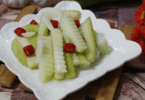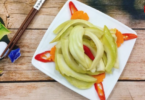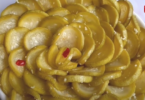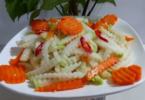Vietnamese Pickled Long Beans (Dau Dua Ngam Chua) – A Traditional Crunch You’ll Love
Looking for a crisp, tangy condiment that brings freshness to your meals? Meet Vietnamese Pickled Long Beans, known in Vietnam as Dau Dua Ngam Chua. This dish is made by pickling fresh yardlong beans in a salty, sour brine, creating a crunchy side that pairs perfectly with rich dishes like braised pork, grilled meats, and rice. In this article, we’ll walk you through the easy ingredients, step-by-step process, and delicious ways to enjoy this traditional dish from Vietnam.
What is Vietnamese Pickled Long Beans (Dau Dua Ngam Chua)?

Vietnamese Pickled Long Beans, also known as Dau Dua Ngam Chua, is a traditional side dish made by soaking fresh yardlong beans in a salty, slightly sour brine. Popular in many Vietnamese households, especially in rural areas, this dish is a perfect example of everyday Vietnamese meals — simple, flavorful, and practical. The long beans are crisp, refreshing, and full of tangy goodness, making them an ideal condiment to pair with rich or greasy foods like braised pork, grilled meats, or fried fish.
In many parts of Vietnam, the dish is served not only during regular family meals but also during holidays, as it adds both flavor and crunch to the table. With minimal ingredients and an easy pickling process, this humble dish continues to be loved by generations.
Ingredients You Need)

- 400g yardlong beans
- 1 tablespoon salt
- 1 tablespoon sugar
- 200ml clean water
- 100ml rice vinegar
- 2 cloves garlic
- 1 red chili
Step-by-Step Pickling Process
Step 1: Prepare the Long Beans

- Wash the Beans: Rinse 400g of yardlong beans under running water to remove dirt.
- Trim and Cut:
- Trim the ends of the beans.
- Cut them into pieces approximately 5–7 cm long.
- Dry the Beans:
- Lay the cut beans on a clean cloth or paper towel.
Allow them to air dry for 1–2 hours; this helps to ensure extra crunch in the final pickles.
- Lay the cut beans on a clean cloth or paper towel.
Step 2: Prepare the Brine

- Measure Ingredients:
- Combine 200ml of clean water (boiled and cooled) with 1 tablespoon of salt and 1 tablespoon of sugar in a small pot.
- Dissolve the Solids:
- Heat the mixture gently over low heat.
- Stir continuously until the salt and sugar completely dissolve.
- Cool the Brine:
- Remove the pot from heat and allow the brine to cool completely to room temperature.
- Using cooled brine prevents the beans from softening due to heat.
Step 3: Pack the Jar

- Prepare Additional Flavorings:
- Slice 2 cloves of garlic thinly.
- Slice 1 red chili (optional) for heat and color.
- Fill the Jar:
- Place the air-dried bean pieces into a clean, dry glass jar.
- Add the sliced garlic and chili to the jar, distributing them evenly among the beans.
- Add the Brine:
- Pour the cooled brine over the beans, ensuring that all pieces are fully submerged.
- Leave about 1 cm of headspace at the top of the jar.
Step 4: Ferment and Store

- Seal and Ferment:
- Seal the jar tightly with its lid.
- Let the jar sit at room temperature for 2–3 days. Check the taste daily; the beans should become slightly sour and retain a crisp texture.
- Refrigerate:
- Once the beans reach your desired level of sourness, move the jar to the refrigerator.
- Keep the jar refrigerated; the pickled beans will stay fresh and crunchy for 7–10 days.
- Serving Tip:
- Always use clean utensils when taking out the pickles to avoid contamination.
Pro Tips for Perfect Vietnamese Pickled Long Beans
1. Dry the Beans Before Pickling: Let the cut long beans air dry for at least 1–2 hours before pickling. Removing excess moisture helps the beans stay extra crunchy after fermentation.
2. Use Boiled and Cooled Water: Always use boiled and cooled water for the brine. This removes chlorine or impurities in tap water that could prevent proper fermentation or cause spoilage.
3. Don’t Over-Pack the Jar: Make sure the beans are loosely packed in the jar so the brine can fully circulate around each piece. This helps ensure even pickling and prevents soft spots.
4. Keep the Beans Fully Submerged: Use a small weight (like a clean spoon or cabbage leaf) to keep the beans below the surface of the brine. Exposure to air may cause mold or discoloration.
5. Avoid Metal Lids or Utensils: Use glass jars and plastic or wooden utensils. Metal can react with the vinegar or salt and affect both flavor and shelf life.
6. Use Younger Beans for Better Crunch: Older long beans can be tough and fibrous. Choose young, tender beans with smooth skin and bright green color — these deliver the best snap when pickled.
7. Watch for Bubbles – They’re a Good Sign!
Tiny bubbles in the brine after 1–2 days mean natural fermentation is happening. This is normal and means your pickles are developing their sour flavor.

Conclusion
Vietnamese Pickled Long Beans (Dau Dua Ngam Chua) are a perfect example of how simple ingredients can create something truly special. With their bright, tangy flavor and satisfying crunch, they bring balance to rich dishes and excitement to everyday meals. This traditional Vietnamese condiment is not only easy to make but also a great way to connect with the flavors of Vietnamese cuisine.
Grab a handful of fresh long beans and follow our easy recipe. Share your creation on social media with the hashtag #VNIFood – we’d love to feature your pickles! Want more authentic Vietnamese food and condiments? Visit our website for new ideas and flavor-packed recipes.
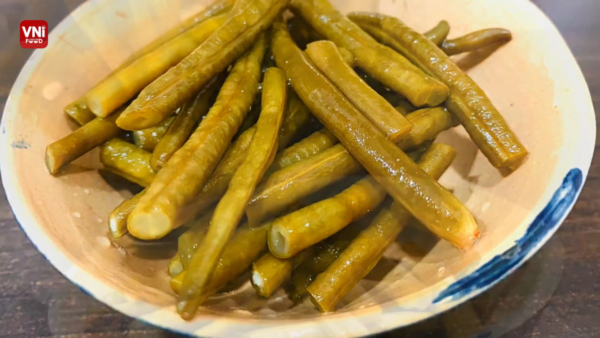
| Prep Time | 15 minutes |
| Servings |
people
|
- 400 g yardlong beans
- 1 tablespoon Salt
- 1 tablespoon Sugar
- 200 ml Water
- 2 cloves garlic
- 100 ml rice vinegar
- 1 Red Chili
Ingredients
|

|
- Prepare the Long Beans Wash the Beans: Rinse 400g of yardlong beans under running water to remove dirt. Trim and Cut: Trim the ends of the beans. Cut them into pieces approximately 5–7 cm long. Dry the Beans: Lay the cut beans on a clean cloth or paper towel. Allow them to air dry for 1–2 hours; this helps to ensure extra crunch in the final pickles.
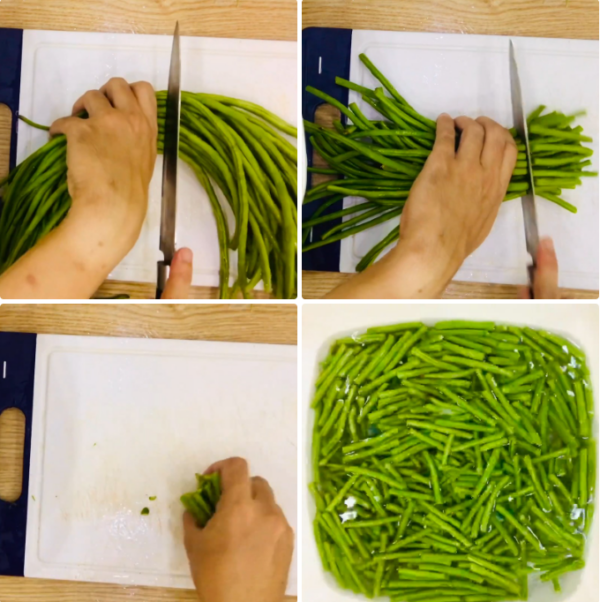
- Prepare the Brine Measure Ingredients: Combine 200ml of clean water (boiled and cooled) with 1 tablespoon of salt and 1 tablespoon of sugar in a small pot. Dissolve the Solids: Heat the mixture gently over low heat. Stir continuously until the salt and sugar completely dissolve. Cool the Brine: Remove the pot from heat and allow the brine to cool completely to room temperature. Using cooled brine prevents the beans from softening due to heat.
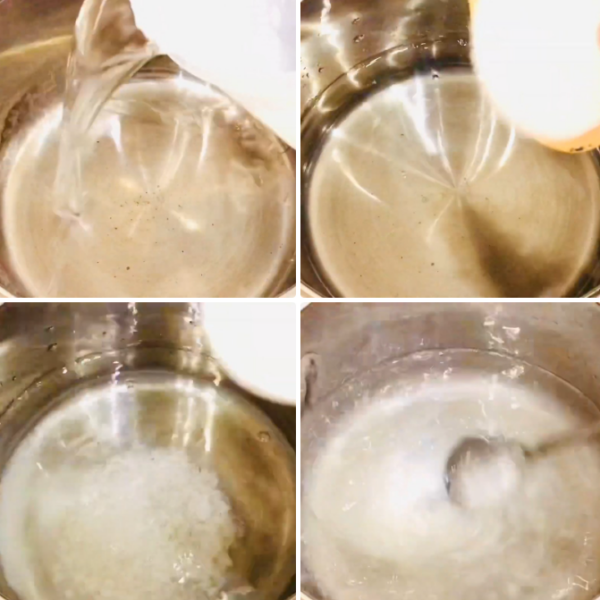
- Pack the Jar Prepare Additional Flavorings: Slice 2 cloves of garlic thinly. Slice 1 red chili (optional) for heat and color. Fill the Jar: Place the air-dried bean pieces into a clean, dry glass jar. Add the sliced garlic and chili to the jar, distributing them evenly among the beans. Add the Brine: Pour the cooled brine over the beans, ensuring that all pieces are fully submerged. Leave about 1 cm of headspace at the top of the jar.
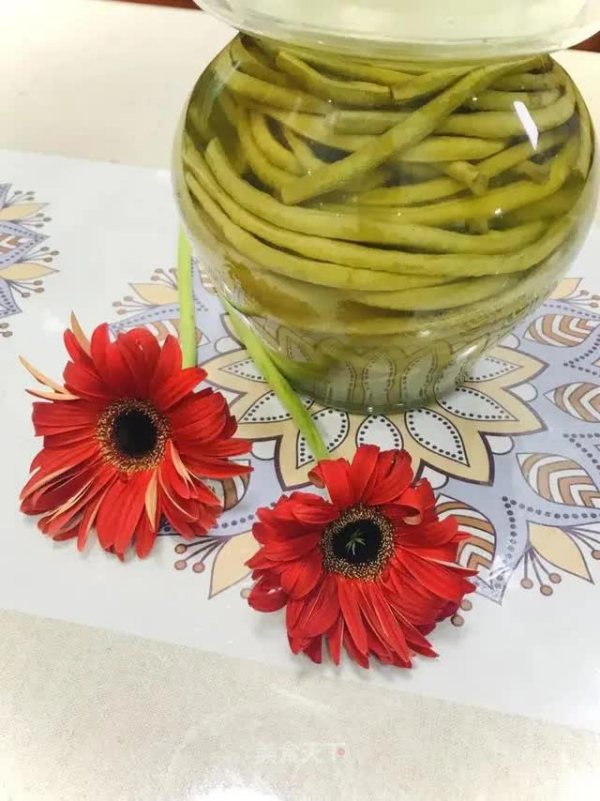
- Ferment and Store Seal and Ferment: Seal the jar tightly with its lid. Let the jar sit at room temperature for 2–3 days. Check the taste daily; the beans should become slightly sour and retain a crisp texture. Refrigerate: Once the beans reach your desired level of sourness, move the jar to the refrigerator. Keep the jar refrigerated; the pickled beans will stay fresh and crunchy for 7–10 days. Serving Tip: Always use clean utensils when taking out the pickles to avoid contamination.



